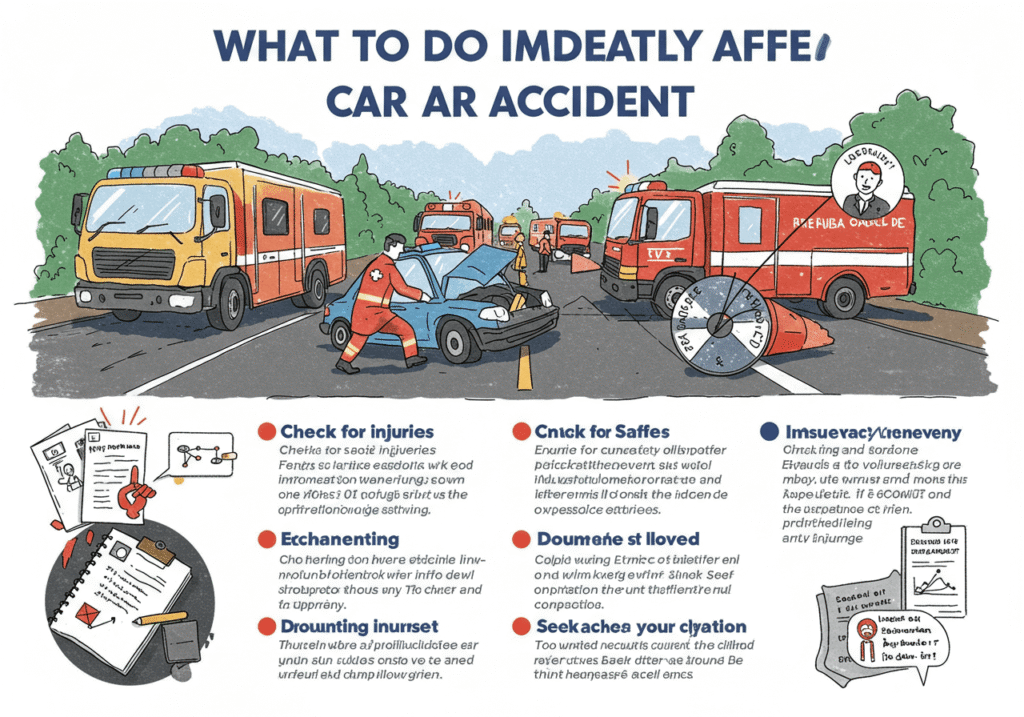Car accidents happen in a split second — but the aftermath can feel like a lifetime. From injuries to insurance claims to legal action, your actions in the first few minutes and days can affect your physical, emotional, and financial recovery.
Did you know?
- Nearly 6 million car accidents occur in the U.S. every year.
- 3 million people are injured annually.
- Many victims miss out on fair compensation because they don’t know what to do immediately after a crash.
That’s why we’ve created this practical, easy-to-follow step-by-step guide — complete with a FREE downloadable checklist — to help you handle a car accident the right way.

📌 Table of Contents
- Before an Accident: Be Prepared
- Step 1: Stay Calm & Check for Injuries
- Step 2: Move to Safety if Possible
- Step 3: Call 911 and the Police
- Step 4: Exchange Information
- Step 5: Gather Evidence at the Scene
- Step 6: Avoid Admitting Fault
- Step 7: Seek Medical Attention Promptly
- Step 8: Notify Your Insurance Company
- Step 9: Keep a Post-Accident Journal
- Step 10: Consult an Experienced Car Accident Lawyer
- ✅ FREE Download: Car Accident Legal Checklist
- Key Mistakes to Avoid
- Frequently Asked Questions
- Final Thoughts
✅ 1. Before an Accident: Be Prepared
Preparation saves lives — and your legal rights.
No one wants to think about a crash, but having the right documents and supplies in your car can make a huge difference.
Keep in your glove box:
- Valid driver’s license and registration
- Proof of insurance
- Emergency contacts
- A notepad and pen
- A disposable camera (or make sure your phone works)
- A first-aid kit
- A copy of this Car Accident Legal Checklist
🚨 2. Step 1: Stay Calm & Check for Injuries
In the immediate aftermath:
✅ Take a deep breath. Try to remain calm.
✅ Check yourself and passengers for injuries.
✅ If you or anyone is seriously hurt, do NOT move — wait for emergency responders.
Pro tip: Shock can mask injuries like concussions, whiplash, or internal bleeding. Seek medical help even if you “feel fine.”
🛑 3. Step 2: Move to Safety if Possible
If your vehicle is drivable and it’s safe:
- Turn on your hazard lights.
- Move the car to the side of the road to avoid blocking traffic.
- If the car is undrivable, stay inside with your seatbelt fastened until help arrives.
Safety first! Don’t stand in active lanes of traffic.
📞 4. Step 3: Call 911 and the Police
Always call the police, even for minor fender benders. A police report is often crucial for:
- Insurance claims
- Determining fault
- Possible legal action
What to tell dispatch:
- Location of the accident
- Number of vehicles involved
- Any injuries
- Hazards (fuel leaks, fire risk)
Cooperate but don’t guess. State only facts you know.
🤝 5. Step 4: Exchange Information
Swap details with the other driver(s):
✅ Full names
✅ Contact information
✅ Driver’s license numbers
✅ License plate numbers
✅ Insurance company and policy number
✅ Make, model, and color of vehicles
If there are witnesses, ask for:
✅ Names and phone numbers
TIP: Take photos of documents in addition to writing them down.
📸 6. Step 5: Gather Evidence at the Scene
Think like an investigator — good evidence is gold for your lawyer later.
Take clear photos of:
- Vehicle damage (all angles)
- License plates
- The overall accident scene
- Road conditions, skid marks, debris
- Traffic signs and signals
- Your injuries (if visible)
Record notes:
- Weather and lighting conditions
- Time and date
- Your memory of what happened
🤐 7. Step 6: Avoid Admitting Fault
In the chaos, you might be tempted to say “I’m sorry.”
Don’t do it.
Anything you say can be used against you later.
✅ Stick to the facts when talking to the police, the other driver, or insurance adjusters.
✅ Let your lawyer and the evidence speak for you.
🏥 8. Step 7: Seek Medical Attention Promptly
Even if you feel okay, get checked by a doctor as soon as possible. Some injuries — like traumatic brain injuries, spinal injuries, or internal bleeding — don’t show symptoms right away.
Why this matters legally:
- Medical records link your injuries directly to the crash.
- Delaying treatment can hurt your claim. Insurance companies may argue you weren’t really injured.
🗂️ 9. Step 8: Notify Your Insurance Company
Most policies require prompt reporting.
✅ Contact your insurance company as soon as possible.
✅ Provide factual details. Don’t speculate.
✅ If the other driver’s insurance contacts you, do not provide a recorded statement without talking to your lawyer first.
📓 10. Step 9: Keep a Post-Accident Journal
Your memory will fade — documentation won’t.
Track:
- Doctor visits
- Treatments and medications
- Days missed from work
- How your injuries affect daily life
- Pain levels
A clear paper trail can increase your compensation.
⚖️ 11. Step 10: Consult an Experienced Car Accident Lawyer
Insurance companies have teams of lawyers — you should too.
A good lawyer can:
✅ Handle negotiations
✅ Protect you from lowball offers
✅ Collect more evidence (like traffic camera footage)
✅ Fight for your rightful compensation in court if needed
Most car accident lawyers offer free consultations and work on a contingency basis — so you pay nothing upfront.
✅ 12. FREE Download: Car Accident Legal Checklist
Don’t leave your legal rights to chance.
We’ve created a simple, printable checklist you can keep in your car. It covers:
✔️ What to do immediately
✔️ What to say (and not say)
✔️ Information to collect
✔️ Photos to take
✔️ How to protect your claim
👉 [Download Your FREE Car Accident Legal Checklist (PDF)]
🚫 13. Key Mistakes to Avoid After a Car Accident
❌ Leaving the scene before exchanging information (may be illegal)
❌ Failing to call the police for documentation
❌ Apologizing or admitting fault
❌ Delaying medical treatment
❌ Talking to the other driver’s insurance without legal advice
❌ Posting about the accident on social media
One misstep can cost you thousands — or your entire claim.
❓ 14. Frequently Asked Questions
✅ What if the other driver flees the scene?
Call the police immediately. Provide any details you remember (license plate, vehicle description). Check for nearby cameras or witnesses.
✅ Should I talk to the other driver’s insurance company?
Never without a lawyer present. They may try to get you to say something that lowers your payout.
✅ What if I was partly at fault?
You may still be entitled to compensation. Many states follow comparative negligence rules. Always talk to a lawyer.
✅ How long do I have to file a claim?
It depends on your state’s statute of limitations. In many states, it’s 2-3 years for personal injury. Missing the deadline means losing your right to sue.
🏆 15. Final Thoughts
A car accident can turn your world upside down in seconds — but knowing exactly what to do can protect your health, your rights, and your financial future.
✅ Stay calm.
✅ Gather evidence.
✅ Get medical care.
✅ Talk to an experienced lawyer.
And don’t forget to download your free checklist and keep it in your glove box — because being prepared is the first step toward recovery.
📥 Ready to Protect Your Rights?
👉 [Download Your FREE Car Accident Legal Checklist Now!]
🔗 Need Help After an Accident?
If you’ve been hurt in a car accident and need legal guidance, our experienced car accident lawyers are here for you.
📞 Contact us today for a free case review.
We fight for accident victims — so you can focus on healing.
